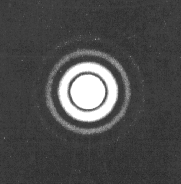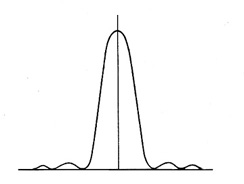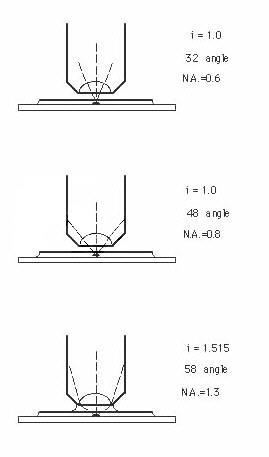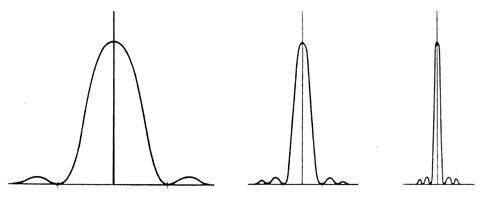Numerical Aperture and Resolution
What is resolution and what does it have to do with the numerical
aperture number of an objective lens (or a condenser lens, for that matter)?
Resolution can be defined as the ability of a microscope to allow one to
distinguish between small objects. In other words, how crisp and sharp
is an image at any given magnification? The numerical aperture number is
directly related to the cone of light from the specimen at its vertex which
is brought into the lens. Simply put, when light hits an object, it diffracts.
A single beam of light will be split into several different diffraction
orders bent at increasing angles from the original impinging beam. The
easiest way to understand this property of light is to consider what happens
when a beam of light is shined through a pinhole onto a dark background.
If the image produced on the other side of the pinhole is examined, one
finds a light pattern known as an Airy disk. It looks like a negative
target with a large central disk of light surrounded by a series of thin
concentric circles of light of decreasing brightness the further away from
the center they are. An image of an Airy disk is shown on the left.
 |
Airy disk

Light transmission curve for an Airy disk

|
 |
(Redrawn from Francon)* |
What has happened is that the light coming out of the pinhole
has been diffracted into several different orders represented by the concentric
circles. The same type of thing happens when light hits a microscopic specimen;
the diffraction orders spread out. The bigger the cone of light brought
into the lens, the more of these diffraction orders which can be collected
by it, and the more information it has to form a resultant image and the
higher the resolving power of the lens will be. The bigger a cone of light
that can be brought into the lens, the higher its numerical aperture is.
Therefore the higher the numerical aperture of a lens, the better the resolution
of a specimen will be which can be obtained with that lens. If you are
interested in learning how the Airy disk is formed and how the light is
diffracted, CLICK
HERE.
The second advantage of using a higher numerical aperture
is that since more orders of diffraction from the object are brought into
the lens, more light generally is brought into a higher numerical aperture
lens producing brighter images. This becomes a major consideration for
darkfield and fluorescence applications where the microscopist is imaging
a bright object against a dark background. The diagram to the lower right
may be useful for this discussion:
| Numerical aperture is defined by the formula
N.A. = i sin q
where I is the index of refraction of the medium
in which the lens is working, and q is one half of the angular aperture
of the lens. All high dry lenses work in air which has a refractive index
of 1.0. Immersion oils have a considerably higher refractive index, sometimes
even up to 1.56. It can be seen from the diagram and from the formula that
using an immersion oil:
-
bends more light into the lens capturing more orders of diffraction
from the object. (Keep in mind that finer details or more closely spaced
objects will give much higher angles of diffraction than will larger objects
with less fine details).
-
will allow a lens to have an N.A. greater than one. It is
not possible for a dry lens to have an N.A. greater than one.
|
 |
(Redrawn from Gray)* |
Notice the third image in the diagram showing the case of
the immersion lens with the N.A. of 1.3. A simple example can be given
to understand how the use of an immersion oil can allow the lens to gather
those outermost diffraction orders. Have you ever noticed when you look
at an aquarium, if you look at the corner you can see the same fish from
both the end and the side of the tank. How does this happen? Well, the
index of refraction of water is greater than that of air; thus, when the
light coming from inside the aquarium hits the air, it is bent at the interface
because of the difference in refractive indices allowing you to see the
fish from both the end and the side at the same time. The same thing happens
when light in the immersion oil hits the end element of the lens and light
is bent inward and the end result is that more diffraction orders are collected
by the lens. And again, the more diffraction orders (image information)
used to form the resultant image, the higher the resolution of the lens
will be.
The following diagram shows what happens to the Airy disk
with increasing numerical aperture. The diffraction maxima are narrowed
and more are brought into the lens to contribute to the final image. These
curves can be correlated with the previous diagram.  (Redrawn
from Francon)*
(Redrawn
from Francon)*
*Diagrams redrawn from Francon, M. 1961.
Progress in Microscopy. Pergamon Press: London (also Row,
Peterson and Co.: Elmsford, NY.) and Gray, P. 1964. Handbook of Basic
Microtechnique. McGraw-Hill: New York.

![]()
![]()




 (Redrawn
from Francon)*
(Redrawn
from Francon)*